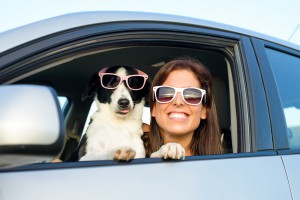
Only a few short decades ago, buckling up was optional for drivers and their passengers, and people were generally unaware of the serious dangers posed by riding in cars without safety belts. Today, all that has changed. Everyone uses a seatbelt, and wisely so. Those riding in the front seat can reduce their risk of fatal injuries by 45 percent and their risk of moderate to critical injury by 50 percent, just by buckling up. In addition, rear seat passengers riding without seatbelts increase the death rate of front seat passengers by up to 5 times.
Unfortunately, while our human passengers are now much safer on road trips, the same can’t be said for our pets. We are still woefully unaware of the importance of securing our furry family members on car rides.
Pet travel is on the rise, and with it is the number of pets who suffer serious injuries from being improperly secured on car rides. In fact, unrestrained or improperly restrained pets can pose a number of serious dangers, both to themselves, and to every passenger in the car.
Even pet travelers who are normally very tranquil and well-behaved can react unexpectedly during a car ride. They may become anxious, overly excited, or frightened. They may jump, run, make noise, or climb the seats – all of which can distract even the most conscientious driver and cause an accident.
What’s more, in the event of an accident, or even a sudden swerve or stop, an unrestrained pet can potentially become a very real hazard. During an accident, a vehicle traveling at just 30 mph can transform a harmless 15-pound child into a projectile with a force of 675 pounds. At the same speed, a 60 pound dog becomes a lethal 2700 pound projectile, which could very easily be flung into a windshield, or another passenger.
Other threats loom after car crashes, as well. In the aftermath of an accident, it’s very possible for a frightened pet to run away, run into traffic, or attack rescue workers or good samaritans who are trying to help.
Pet parents who are responsible in every other way often overlook the dangers of failing to restrain their pets. Many assume that because they’re just headed to the bank, or the pet store, or the dog park a couple of miles away, they’re relatively safe. However, most accidents occur during short trips around town – not on busy highways.
Fortunately, there are plenty of ways to safely restrain your pet without restricting his freedom or fun. A wide variety of vehicle restraint options are available for pet parents, and with a little research, you can find one that will perfectly suit your individual pet’s needs. Pet safety belts, pet car seats (with built-in seat belts), pet travel crates & kennels, and vehicle pet barriers are some of the best and safest choices.
Whichever pet restraint method you choose, be sure that you know how to use it properly, and that you give your pet ample time to adapt. If you choose a travel crate, you should begin acclimating him to it inside your home.
Place some of your pet’s favorite toys, loveys, or blankets inside the crate. Let your pet explore the crate, and go in and out at will. Once he seems used to the crate, place it in your vehicle and put him inside. Take a short car ride or two, then longer and longer rides until he seems completely comfortable.
If you choose a pet safety belt, let your pet wear the harness around the house, and give him time to get used to the feel of it before strapping them in the car. Start out with short car rides, then gradually extend them, just as you would the crate.
A couple of final tips: regardless of your chosen method of restraint, back seat or cargo area travel is always safest. Also, while your pet’s safety is essential, so is his comfort. Make sure his "seat" is comfortable, and that his restraint fits well and is properly placed.
Our pets depend completely on us for their care and their safety. Let’s do right by them, and make sure they are as safe and secure as our other family members in the car.
TripsWithPets.com is the premier online pet friendly travel guide -- providing online reservations at over 30,000 pet friendly hotels & accommodations across the U.S. and Canada. When planning a trip, pet parents go to TripsWithPets.com for detailed, up-to-date information on hotel pet policies and pet amenities. TripsWithPets.com also features airline & car rental pet policies, pet friendly activities, a user-friendly search-by-route option, as well as pet travel gear. For more information, please visit http://www.tripswithpets.com




